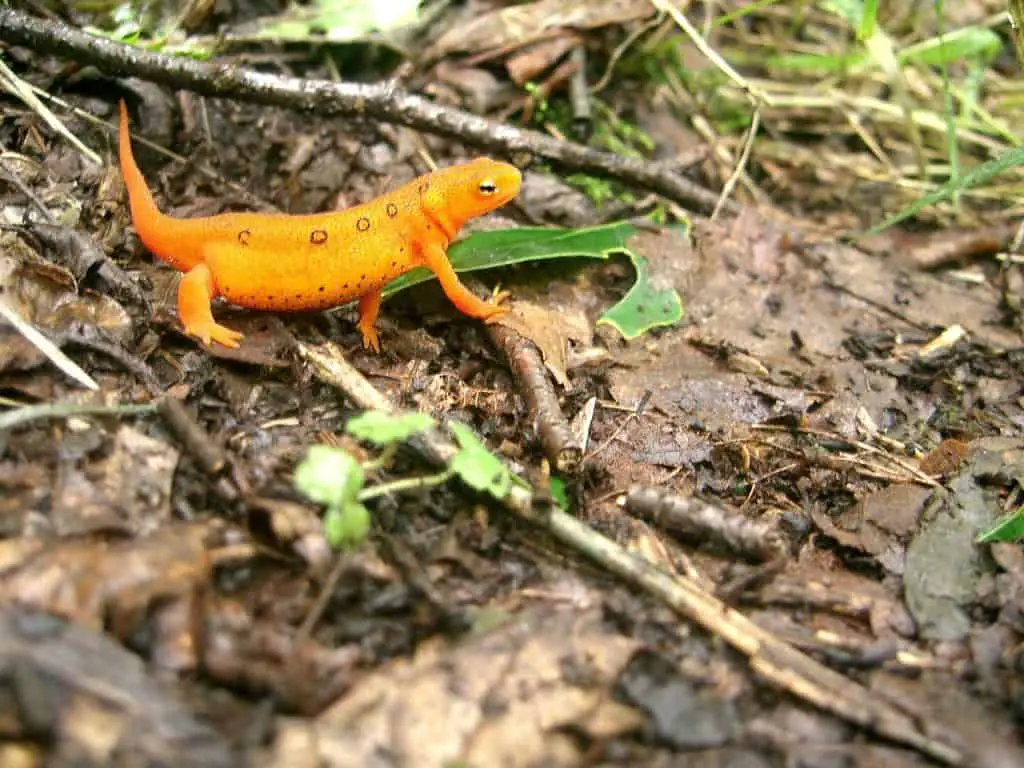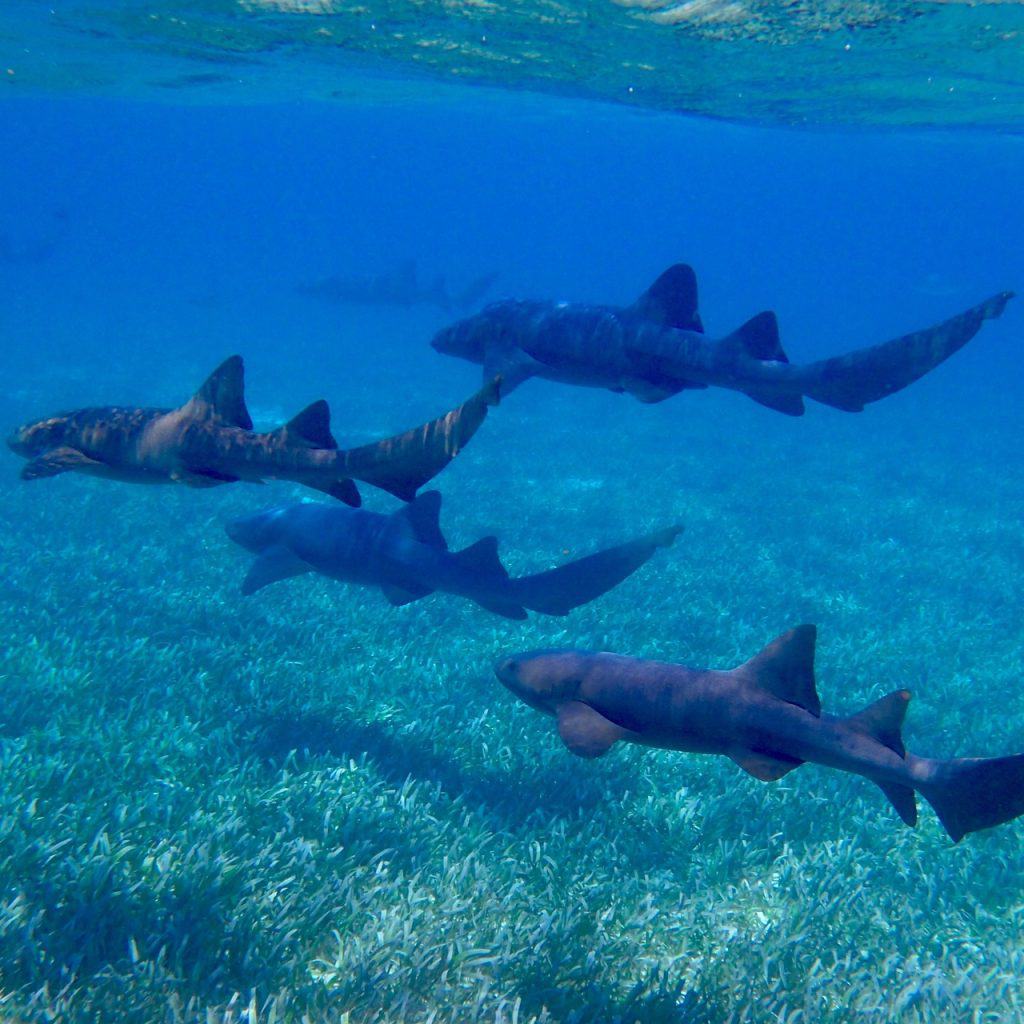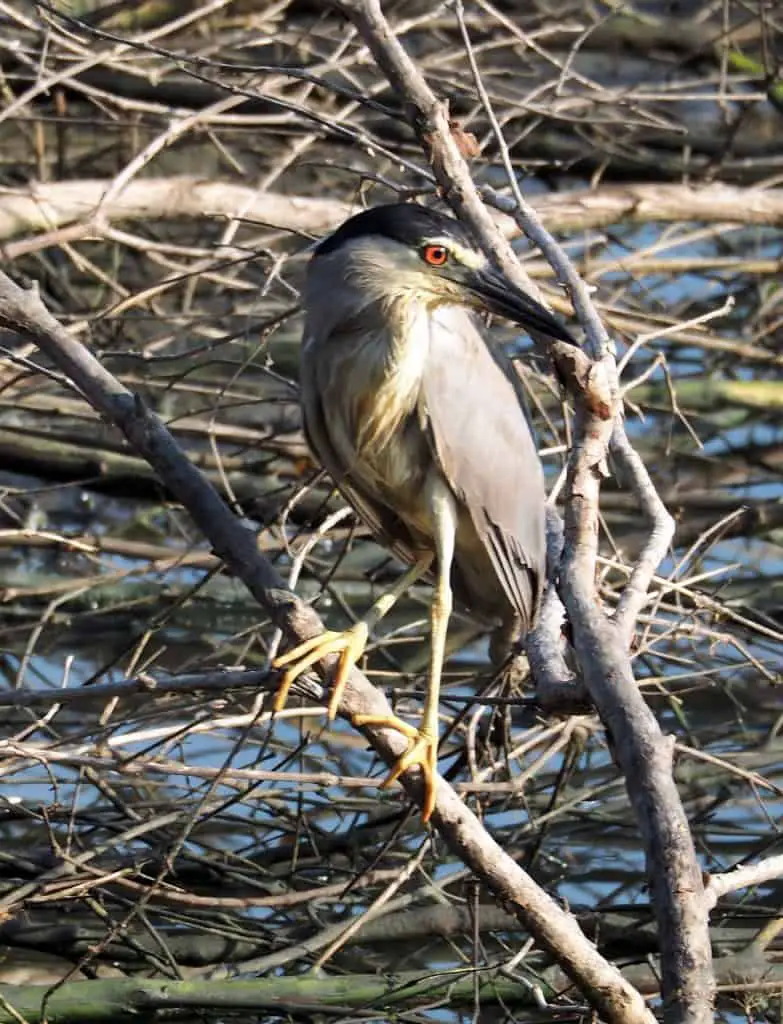The world is full of animals starting with n. In fact, thousands of animals have names that start with the letter n. From narwhals to nutria and everything in between, you can find plenty of ‘n’ animals.
While it’s impossible to create a comprehensive list of animals that start with n, you’ll find a good start below. I’ve compiled a list of my favorite animals that start with the letter n. Is your favorite on the list?
Animals starting with N
Need a list of ‘N is for animal’ fun? You are in the right place. I share some of the many animals that start with the letter N below.
1. Narwhal

When you think of animals starting with n, your mind might jump to narwhals.
With their enchanting presence in the frigid Arctic waters, narwhals (Monodon monoceros) stand as one of nature’s most captivating marvels. Renowned for their distinct spiraling tusk, which can reach lengths of up to ten feet, these elusive creatures cast an ethereal aura upon their icy realm.
The narwhal’s elongated tusk is actually an elongated tooth, protruding from the upper jaw of males, and occasionally from females as well. And scientists still aren’t quite sure what the whales use this tusk for. Some think it’s a tool to sense environmental changes. But that’s not confirmed because these whales are notoriously difficult to study. It’s a mystery that keeps me up at night!
Sporting a sleek and streamlined physique, narwhals are strikingly beautiful. Their smooth, mottled grayish-blue skin effortlessly blends with the icy depths they call home. These remarkable marine mammals, measuring up to 16 feet in length and weighing around 3,500 pounds, possess a gracefulness that belies their size.
Narwhals thrive in the Arctic waters of Canada, Greenland, Norway, and Russia, often congregating in tight-knit pods numbering in the hundreds. They exhibit a strong affinity for the edges of drifting sea ice, their preferred hunting grounds. Underneath the frozen surface, these skilled divers gracefully navigate the depths, preying on fish, squid, and shrimp with remarkable precision.
2. Newt

In the often murky realm of freshwater ecosystems, newts (Salamandridae) emerge as vibrant gems, captivating all who encounter them. With their distinctive slender bodies and smooth, moist skin, these small amphibians possess an otherworldly charm. Their kaleidoscope of colors, ranging from fiery oranges and yellows to rich greens and browns, adds an iridescent touch to their overall appearance.
While newts may seem fragile and delicate, they harbor remarkable regenerative abilities. If threatened or attacked, they can shed their tails, which will later regrow, offering them a unique advantage for survival. However, despite their remarkable resilience, newts face growing conservation concerns. Habitat destruction, pollution, and the introduction of non-native species pose significant threats to their populations.
3. Nighthawk
In the dusk-laden skies, nighthawks (Chordeiles minor) emerge as masters of twilight, captivating onlookers with their aerial prowess. These slender, medium-sized birds possess a cryptic blend of gray, brown, and black feathers that seamlessly camouflage them against the dusky backdrop. With long, pointed wings and a graceful flight pattern, nighthawks slice through the air with remarkable agility and precision.
Nighthawks favor a range of habitats, from open grasslands and prairies to woodland edges and urban areas. Their adaptable nature allows them to thrive in diverse landscapes across the Americas. However, their true domain lies within the night sky, as their name suggests. As crepuscular and nocturnal hunters, nighthawks utilize their keen eyesight and wide mouths to feast on a diet consisting primarily of flying insects, capturing their prey on the wing with astonishing accuracy.
4. Numbat

In the vast and arid landscapes of the Australian Outback, numbats (Myrmecobius fasciatus) grace the woodland habitats with their unique charm. These small, diurnal marsupials are known for their slender bodies adorned with striking bands of reddish-brown and white stripes. With a pointed snout and a long, bushy tail, numbats possess an elegant appearance that captures the essence of their distinctive presence.
Numbats have a strong affinity for eucalypt woodlands and dry sclerophyll forests, where they weave their way through the dense undergrowth in search of their primary food source: termites. With their long, sticky tongues, they skillfully extract termites from their intricate mounds, feasting on thousands of these tiny insects each day. Their specialized diet as termite eaters, or myrmecophagous animals, contributes to their ecological importance as natural pest controllers.
While numbats were once widely distributed across southern Australia, their population has experienced a significant decline.
5. Nutria

In the watery realms of wetlands and marshes, nutria (Myocastor coypus) emerge as industrious creatures, leaving their mark on the landscape. These semi-aquatic rodents boast a stout, round bodies covered in thick, coarse fur that ranges in color from dark brown to reddish-brown.
Nutria demonstrate a remarkable adaptability to various wetland habitats, including freshwater marshes, swamps, and estuaries. Equipped with webbed hind feet and a strong paddle-shaped tail, they navigate these water-rich environments with ease, displaying their affinity for an aquatic lifestyle.
While nutria have proven resilient in their ability to thrive in wetland ecosystems, their introduction to certain regions outside their native range has raised concerns. For example, I’ve only ever seen nutria in the swamps of south Louisiana, where they are considered a pest.
6. Nene (Hawaiian goose)

The nene is a goose well-adapted to its home in the Hawaiian Islands. Nenes are endemic to Hawaii, and they favor a range of environments, from coastal lowlands to high-altitude volcanic slopes.
While the nene holds a special place in Hawaiian culture and folklore, its existence has not been without challenges. Historically, it faced severe population declines due to habitat destruction, predation, and hunting. However, through dedicated conservation efforts, including captive breeding programs and habitat restoration, the nene’s conservation status has improved.
7. Nudibranch (sea slug)

While nudibranchs are relegated to the title ‘sea slug,’ these creatures are anything but a boring old slug. Instead, this order of sea creatures wows with a surprising array of colors and shapes. Their soft, uncoiled bodies are adorned with ornate fringes, feathery gills, and vivid appendages that create a breathtaking display of nature’s artistry.
Nudibranchs can be found in a diverse range of marine habitats, from coral reefs to rocky shores and even deep-sea trenches. They exhibit a preference for specific food sources, often specializing in consuming particular types of sponges, hydroids, or other organisms.
Although you might not expect sea slugs to be too exciting, the vivid colors make these fascinating creatures (at least to me!).
8. Nilgai (Indian antelope)

Roaming the vast plains and scrublands of the Indian subcontinent, the nilgai (Boselaphus tragocamelus) commands attention. These large antelopes, also known as blue bulls, exhibit a striking combination of colors. Males have a bluish-gray coat, while females and juveniles showcase a warm reddish-brown hue.
Nilgai display a preference for open grasslands, arid plains, and dry deciduous forests. Their adaptability enables them to thrive in diverse habitats, from low-lying coastal areas to the foothills of mountain ranges. These agile herbivores are equipped with strong jaws and specialized teeth that allow them to graze on a variety of grasses, herbs, and shrubs.
Surprisingly, you can find 30,000 of these creatures in southeast Texas. A rancher brought them over in the 1920s and their population has gotten out of hand.
9. Nurse shark

Nurse sharks (Ginglymostoma cirratum) gracefully glide through tropical waters. The sharks possess a distinct appearance, characterized by their sleek, cylindrical bodies and broad, rounded heads. Their sandy-colored skin, adorned with dark spots and small spiracles behind the eyes, offers a perfect camouflage amidst the coral reefs and sandy seabeds they call home.
As nocturnal predators, they venture out under the cover of darkness, utilizing their keen senses to detect hidden prey such as fish, crustaceans, and mollusks. Their gentle nature and preference for resting on the ocean floor earn them the reputation of being docile and unthreatening to humans.
Although I’ve certainly been startled by a big nurse shark or two while diving, I’ve never felt in danger around these relatively gentle creatures. As long as you don’t provoke the animal, you should be safe in the presence of a nurse shark.
10. Nautilus

The nautilus (Nautilus pompilius) roams as a living relic from the distant past. This captivating cephalopod possesses a distinctive spiral-shaped shell that serves as its protective home. The nautilus exhibits an exquisite design, with a pearly, iridescent exterior that shimmers in the faint light of the deep-sea.
Nautiluses are primarily found in the warm tropical waters of the Pacific and Indian Oceans, inhabiting deep-sea slopes and coral reefs. These ancient mariners have a slow growth rate, with individuals gaining new chambers in their shells as they mature.
As one of my favorite creatures, I couldn’t write a list of animals starting with n without these beauties!
11. Nightingale

As the sun sets and darkness envelops the landscape, the nightingale (Luscinia megarhynchos) emerges as a lyrical maestro, captivating listeners with its enchanting melodies. This small passerine bird possesses a plain brown plumage, allowing it to blend effortlessly into its surroundings. Its stout beak and relatively short wings belie the incredible vocal range and musical prowess that make it a celebrated songster.
These elusive birds are migratory, spending summers in temperate regions of Europe and western Asia, and undertaking long journeys to wintering grounds in sub-Saharan Africa. They seek shelter amidst the foliage, where they create intricate nests on or near the ground.
12. Naked mole rat
Naked mole (Heterocephalus glaber) rats are specialized inhabitants of the underground, dwelling in intricate tunnel systems found in arid regions of East Africa. These small mammals boast hairless, wrinkled skin that ranges from pink to grayish-brown, making them distinctively different from their furry counterparts. Their bodies are built for a life spent burrowing, with short legs, powerful claws, and elongated, tube-like structures for both breathing and social communication.
Their burrows provide them protection from predators and maintain stable environmental conditions. These fascinating creatures display a eusocial behavior, living in highly organized colonies with a queen, workers, and soldiers, each playing a vital role in the survival of the colony.
13. Nematode
Nematodes can be found in virtually every corner of the Earth, from the depths of the ocean trenches to the highest mountain peaks. Their ability to adapt and thrive in various habitats is a testament to their remarkable resilience. These organisms play crucial ecological roles, contributing to nutrient recycling, decomposition, and the balance of soil ecosystems.
These slender, unsegmented worms display a range of sizes and shapes, with some species barely visible to the naked eye, while others can grow several centimeters long.
14. Nile crocodile

In the mighty rivers and waterways of Africa, the Nile crocodile (Crocodylus niloticus) reigns as an impressive and formidable predator. These ancient reptiles exhibit a robust and muscular body, covered in rough, scaly skin that ranges in color from grayish-brown to olive-green.
Nile crocodiles primarily inhabit freshwater habitats such as rivers, lakes, and swamps, utilizing their keen sense of sight and stealthy underwater maneuvers to ambush unsuspecting prey. They are highly adaptable and can thrive in a range of environments, from arid savannas to lush wetlands, as long as they have access to suitable aquatic habitats for hunting and basking.
No list of animals starting with the letter n would be complete without these creatures.
15. Northern fur seal

In the chilly waters of the North Pacific Ocean, the northern fur seals (Callorhinus ursinus) command attention with their sleek, dark brown fur and charismatic presence. These marine mammals possess a robust and streamlined body, perfectly adapted for life both in the water and on land. Adult males boast a distinctive “mane” of coarse hair on their necks, lending them a regal appearance.
They rely on rich, cold-water ecosystems to sustain their diet, which primarily consists of fish and squid. These social creatures exhibit gregarious behavior, often gathering in large colonies during breeding and molting seasons.
16. Narrow-headed softshell turtle

The narrow-headed softshell turtle (Chitra indica) is a distinctive turtle species possesses a unique physical appearance, characterized by its flattened shell, elongated snout, and slender body. With a smooth, leathery skin and a coloration that varies from olive to brown, these turtles effortlessly glide through the water, blending seamlessly with their surroundings.
These turtles primarily inhabit freshwater ecosystems, favoring slow-moving rivers, lakes, and ponds with sandy or muddy bottoms. They are highly adapted for an aquatic lifestyle.
Unfortunately, the narrow-headed softshell turtle is currently listed as “Critically Endangered” by the International Union for Conservation of Nature (IUCN). Habitat loss, pollution, and unsustainable fishing practices pose significant threats to their survival.
17. Northern Saw-whet Owl

The northern saw-whet owl (Aegolius acadicus) are stealthy hunters who have earned a spot on this list of animals starting with n.
These owls primarily feed on small mammals, such as mice and voles, which they capture with exceptional precision and agility. These successful hunters are even more impressive when you realize these animals are very small, with the larger females reaching 21.5 cm (~8 inches) long and 100 grams.
Despite their diminutive size, their keen eyesight and acute hearing make them formidable predators of the night. With a small stature and large, round head adorned with distinctive facial disks, these owls possess an endearing charm. Their plumage varies in shades of brown and gray, providing exceptional camouflage amidst the dense foliage of their woodland habitats.
18. Natal ghost frog
The Natal ghost frog (Heleophryne natalensis) is a South American amphian. This unique frog species boasts a small and stocky body, with webbed feet and large, round eyes that hint at its nocturnal nature. Its coloration varies from shades of brown to gray, allowing it to blend effortlessly with its surroundings.
Natal ghost frogs prefer moist and cool habitats, commonly found in the damp crevices and leaf litter of forest floors.
19. Nicobar pigeon

The Nicobar pigeon (Caloenas nicobarica) is a bird that boasts iridescent plumage shimmering in hues of green, bronze, and purple. Its long, elegant tail feathers further enhance its striking appearance.
Nicobar pigeons inhabit dense forests, mangroves, and coastal areas of the Nicobar Islands, Andaman Islands, and other neighboring islands.
20. Northern leaf-tailed gecko

In the dense rainforests of northeastern Australia, the Northern Leaf-Tailed Gecko (Saltuarius cornutus) silently reigns as a master of disguise.
This undercover reptile possesses a unique physical appearance, characterized by its flattened body and a tail that resembles a leaf. Its rough skin, covered in intricate patterns and textures, perfectly mimics the bark and foliage of its arboreal habitat.
21. Northern night monkey
The Northern Night Monkey (Aotus trivirgatus) has large, expressive eyes and soft, dense fur, this small primate exudes an enchanting charm.
Northern Night Monkeys predominantly inhabit the lush canopies of tropical rainforests, favoring areas with high humidity and dense vegetation. These adept climbers spend their nights foraging for fruits, leaves, insects, and even small vertebrates, showcasing their omnivorous nature. Their nocturnal lifestyle allows them to navigate their arboreal homes under the moonlit sky.
22. Needlefish
In the shimmering coastal waters of tropical and subtropical regions, the needlefish of the family Belonidae possesses a sleek physique. With their elongated, slender bodies and beak-like jaws, these sleek fish are built for speed and precision.
Needlefish thrive in a variety of habitats, including mangrove swamps, estuaries, and shallow coastal waters. These adaptable creatures have earned a place on this list of animals starting with n.
23. Nabarlek
Hidden among the rugged landscapes of northern Australia, the nabarlek (Petrogale concinna) is a small wallaby species is characterized by its compact size, with males weighing around 4 kilograms and females slightly smaller. Their fur is a beautiful combination of gray and reddish-brown, providing excellent camouflage in their rocky habitats.
24. Nursery fish
As the name suggests, nursery fish (Kurtus) are involved in protecting their young from predators. These fish have a distinctive elongated body shape, often with vibrant colors and intricate patterns adorning their scales. Their adaptations include hook-like extension on the head, which leaves a space for a cord of egg membranes to rest on the males’ heads.
25. Nyala

On the list of animals starting with n, we can’t overlook the nyala.
The nyala (Tragelaphus angasii) is a medium-sized antelopes that showcase distinct sexual dimorphism, with males exhibiting a striking appearance. They possess elegant, spiraled horns that can reach up to 70 centimeters in length, adding to their regal allure. Both males and females feature a reddish-brown coat adorned with white vertical stripes, enhancing their camouflage within the lush vegetation.
Nyala prefer dense bushlands and riverine forests, where they can find ample cover and abundant food sources.
26. Numbray
In the tropical waters of the Indo-Pacific, the numbray (Narke dipterygia) gracefully glides through the coral reefs, captivating observers with its distinct diamond-shaped body with a striking pattern of black spots on a light-colored background.
The numbray earned its name because it will make your arm go numb if you touch it. The electric shock is made possible by the numbray’s specialized electric organs known as ampullae of Lorenzini. These organs detect electric fields in the water, allowing the numbray to locate hidden prey and navigate its surroundings. When threatened or during courtship rituals, the numbray can generate a mild electric shock, which serves as both a defense mechanism and a form of communication.
27. Night Heron

The night heron (Nycticorax spp.) is a mysterious and captivating bird that roams the world’s wetlands and waterways. With its sleek and compact body, adorned in shades of gray, black, and white, the night heron is a true master of stealth. Its piercing yellow eyes and dagger-like beak add to its enigmatic charm.
Night herons prefer waterfront habitats, including marshes, swamps, and mangroves, where they can easily hide and hunt for their favorite prey—fish, crustaceans, and amphibians. These skilled hunters patiently await their prey, striking with lightning speed to secure their next meal.
28. Nuthatch

The nuthatch (Sitta spp.) is a nimble and charismatic bird. With its compact body, short wings, and strong beak, the nuthatch showcases a delightful blend of agility and determination. Its plumage includes a combination of earthy browns, grays, and vibrant hues, creating a mosaic of colors that harmonize with its woodland surroundings.
The nuthatch finds its haven amidst the diverse habitats of forests and woodlands, favoring mature trees that provide ample hiding spots and foraging opportunities. Its unique adaptation allows it to navigate tree trunks and branches with remarkable ease, often moving headfirst or upside down as it searches for insects, seeds, and nuts. Its sharp bill aids in prying open crevices to extract its food, while its strong feet provide stability during its acrobatic foraging endeavors.
29. Nutcracker

In the coniferous forests of the northern hemisphere, the nutcracker (Nucifraga spp.) can be found cracking nuts. (Not surprising based on the name!).
With its robust build, pointed beak, and strong claws, the nutcracker embodies a unique adaptation for its seed-focused lifestyle. Its plumage combines earthy tones with accents of black and white, presenting a striking contrast against the evergreen backdrop.
Equipped with a sturdy bill designed for cracking open pine cones, the nutcracker expertly extracts seeds and stores them in caches throughout its territory. This behavior ensures a vital seed reservoir during harsh winter months and aids in forest regeneration.
30. Nandu

Venture into the vast grasslands and shrublands of South America, and you’ll encounter the remarkable nandu (Rhea spp.). With its slender body, long neck, and powerful legs, this flightless bird captivates with its elegant stature and swift movements. The nandu’s plumage showcases a blend of earthy browns and grays, perfectly camouflaging it among the grassy landscapes it calls home.
With its strong legs and agile stride, it navigates the terrain with grace and speed, reaching impressive running speeds to evade predators and cover large distances. Its long neck allows it to peck at vegetation and graze on grasses, seeds, and even small invertebrates.
Final Take on animals starting with N
Animals starting with n represent a wide range of the animal kingdom. While this isn’t a comprehensive list, it’s a great place to find one of your favorite creatures.
My favorite is the nautilus (or maybe the nudibranchs!). What’s yours?
